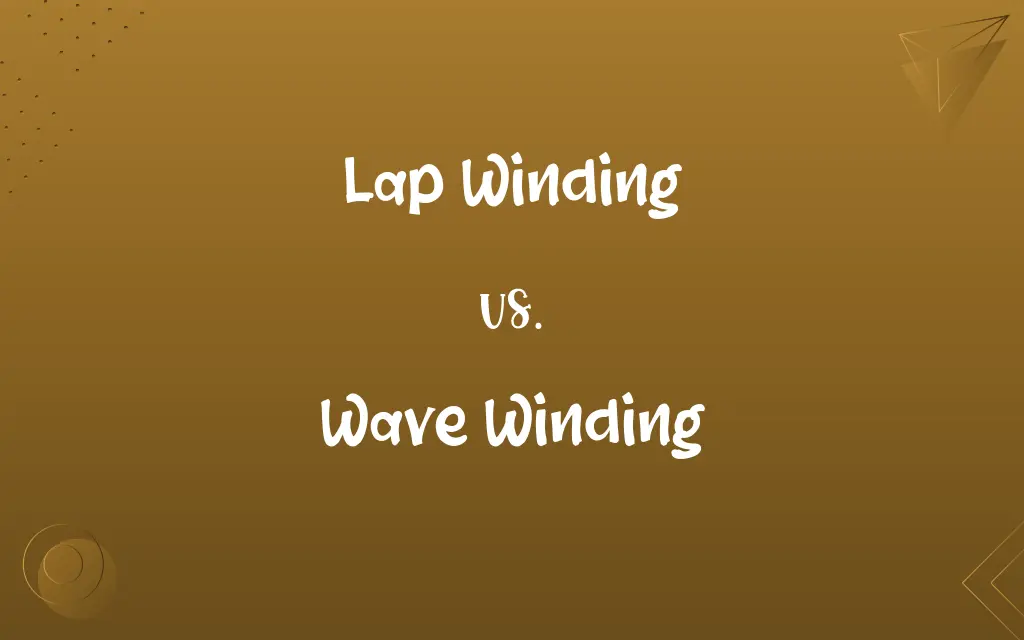Lap Winding vs. Wave Winding: Know the Difference

By Shumaila Saeed || Published on February 8, 2024
Lap winding consists of many turns per coil, connected in parallel paths, ideal for high current and low voltage. Wave winding has fewer turns per coil, connected in series paths, suitable for high voltage and low current.

Key Differences
Lap winding is characterized by its parallel paths and multiple turns per coil, with each coil overlapping the next, resembling a 'lap'. In contrast, wave winding has a series layout with fewer turns per coil, forming a wave-like pattern across the armature.
Shumaila Saeed
Feb 08, 2024
Lap winding is designed for machines that require high current at low voltage. It offers multiple parallel paths for current flow, reducing the total resistance. Wave winding, on the other hand, is suitable for high voltage applications, with its series configuration allowing for higher voltage generation.
Shumaila Saeed
Feb 08, 2024
Lap winding is commonly used in applications such as large generators and motors where high current is needed. Wave winding finds its use in machines where high voltage is essential, like in small motors and generators.
Shumaila Saeed
Feb 08, 2024
Lap winding, due to its complex construction, can be more expensive and less efficient for high-speed machines. Wave winding offers better efficiency at high speeds but may incur higher costs in high-voltage applications.
Shumaila Saeed
Feb 08, 2024
Lap winding offers more flexibility in terms of design and is adaptable to various current requirements. Wave winding, with its simpler design, is less adaptable but provides efficiency in specific high-voltage scenarios.
Shumaila Saeed
Feb 08, 2024
ADVERTISEMENT
Comparison Chart
Voltage and Current
Suitable for high current, low voltage
Suitable for high voltage, low current
Shumaila Saeed
Feb 08, 2024
Application
Ideal for large motors and generators
Used in small motors and generators
Shumaila Saeed
Feb 08, 2024
ADVERTISEMENT
Lap Winding and Wave Winding Definitions
Lap Winding
Lap winding is used predominantly in electrical machines requiring high torque.
Our industrial motor uses lap winding for its high-torque needs.
Shumaila Saeed
Jan 16, 2024
Wave Winding
Wave winding is a type of armature winding in electric machines where coils are connected in series, forming a wave-like pattern.
The generator was efficient at high voltage due to its wave winding.
Shumaila Saeed
Jan 16, 2024
Lap Winding
In lap winding, each coil is connected in parallel to the adjacent coils.
The lap winding in the generator ensured efficient current distribution.
Shumaila Saeed
Jan 16, 2024
Wave Winding
Wave winding is characterized by fewer turns per coil and fewer parallel paths.
Due to the wave winding design, the motor operated efficiently at higher speeds.
Shumaila Saeed
Jan 16, 2024
Lap Winding
Lap winding is characterized by multiple turns of wire in each coil.
The lap winding's multiple turns increased the torque of the motor.
Shumaila Saeed
Jan 16, 2024
ADVERTISEMENT
Wave Winding
Wave winding is typically used in machines where high voltage and low current are required.
Small generators often use wave winding to achieve the necessary high voltage.
Shumaila Saeed
Jan 16, 2024
Lap Winding
Lap winding is a method of winding armature coils in a generator or motor, where each coil overlaps the next.
The motor's lap winding was designed for high current applications.
Shumaila Saeed
Jan 16, 2024
Wave Winding
Wave winding allows for a simpler construction in high voltage applications.
The simplicity of the wave winding made the maintenance of the equipment easier.
Shumaila Saeed
Jan 16, 2024
Lap Winding
Lap winding allows for multiple parallel paths within the armature.
The lap winding's parallel paths reduced the overall resistance in the circuit.
Shumaila Saeed
Jan 16, 2024
Wave Winding
In wave winding, each coil is connected end-to-end in a series configuration.
The motor's wave winding provided high voltage output with fewer turns per coil.
Shumaila Saeed
Jan 16, 2024
Repeatedly Asked Queries
What is Wave Winding?
Wave winding is an armature winding technique where coils are connected in series, forming a wave-like pattern, suitable for high voltage applications.
Shumaila Saeed
Feb 08, 2024
Where is Wave Winding commonly used?
Wave winding is used in smaller motors and generators where high voltage and low current are desired.
Shumaila Saeed
Feb 08, 2024
What are the advantages of Lap Winding?
Lap winding offers high current output, multiple parallel paths, and adaptability to various current requirements.
Shumaila Saeed
Feb 08, 2024
Where is Lap Winding commonly used?
Lap winding is typically used in large electric motors and generators that require high current output.
Shumaila Saeed
Feb 08, 2024
How does Wave Winding affect the performance of a motor?
Wave winding allows for higher voltage output, making the motor efficient for applications requiring high speed and low current.
Shumaila Saeed
Feb 08, 2024
What is Lap Winding?
Lap winding is a method where armature coils in electrical machines are wound in such a way that each coil overlaps the next, creating multiple parallel paths.
Shumaila Saeed
Feb 08, 2024
What are the advantages of Wave Winding?
Wave winding provides high voltage output with fewer turns per coil and is efficient at high speeds.
Shumaila Saeed
Feb 08, 2024
Can Wave Winding be used for high current applications?
Wave winding is not typically used for high current applications as it is designed for high voltage and low current output.
Shumaila Saeed
Feb 08, 2024
How does Lap Winding affect the performance of a motor?
Lap winding increases the torque and current capacity of a motor, making it suitable for heavy-duty applications.
Shumaila Saeed
Feb 08, 2024
Is Lap Winding more complex than Wave Winding?
Yes, lap winding is generally more complex due to its multiple parallel paths and overlapping coil design.
Shumaila Saeed
Feb 08, 2024
How does Lap Winding affect the cost of a motor?
Lap winding can increase the cost of a motor due to its complex design and the need for more winding material.
Shumaila Saeed
Feb 08, 2024
How does Wave Winding affect the cost of a motor?
Wave winding can be cost-effective for high voltage applications but may incur higher costs in high-performance scenarios.
Shumaila Saeed
Feb 08, 2024
Can Lap Winding be used in small motors?
While possible, lap winding is not typically used in small motors due to its design being more suitable for high current applications.
Shumaila Saeed
Feb 08, 2024
Can Lap Winding be used for high voltage applications?
Lap winding is less suitable for high voltage applications compared to wave winding due to its design for high current output.
Shumaila Saeed
Feb 08, 2024
Can Wave Winding be used in large motors?
Wave winding can be used in large motors, particularly when high voltage and efficiency at high speeds are required.
Shumaila Saeed
Feb 08, 2024
What are the design challenges with Lap Winding?
The main challenge with lap winding is managing the complexity and ensuring efficient current distribution among multiple parallel paths.
Shumaila Saeed
Feb 08, 2024
What are the design challenges with Wave Winding?
In wave winding, the challenge lies in maintaining efficiency at high voltages while managing the simpler series coil configuration.
Shumaila Saeed
Feb 08, 2024
Is Wave Winding more efficient than Lap Winding?
Wave winding can be more efficient in certain applications, especially those requiring high voltage and low current.
Shumaila Saeed
Feb 08, 2024
Share this page
Link for your blog / website
HTML
Link to share via messenger
About Author
Written by
Shumaila SaeedShumaila Saeed, an expert content creator with 6 years of experience, specializes in distilling complex topics into easily digestible comparisons, shining a light on the nuances that both inform and educate readers with clarity and accuracy.








































































